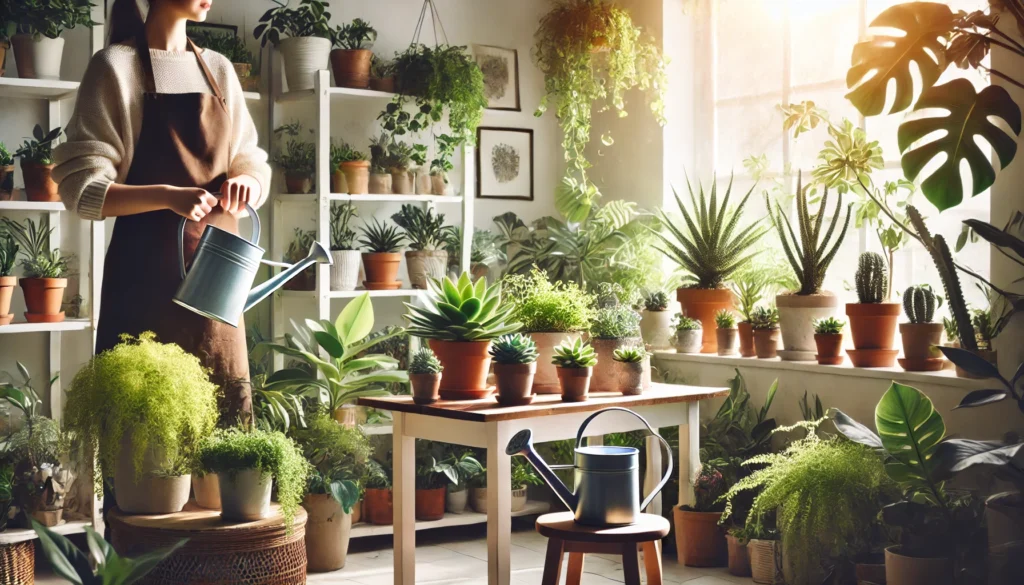
Ultimate Guide to Indoor Plant Watering Schedule: Best Practices for Healthy Growth
Watering is one of the most crucial aspects of indoor plant care, yet it’s often the source of confusion and frustration for plant parents. An effective indoor plant watering schedule can mean the difference between a thriving, lush garden and a collection of drooping, discolored leaves. Without a structured approach, overwatering or underwatering can damage your plants beyond repair. In this guide, we’ll show you how to develop an easy and effective watering routine that caters to your plants’ specific needs, ensuring their health and vibrancy year-round. Whether you’re a seasoned gardener or a beginner, mastering your plant’s watering schedule is key to success.
Table of Contents
ToggleUnderstanding Your Plant’s Water Needs
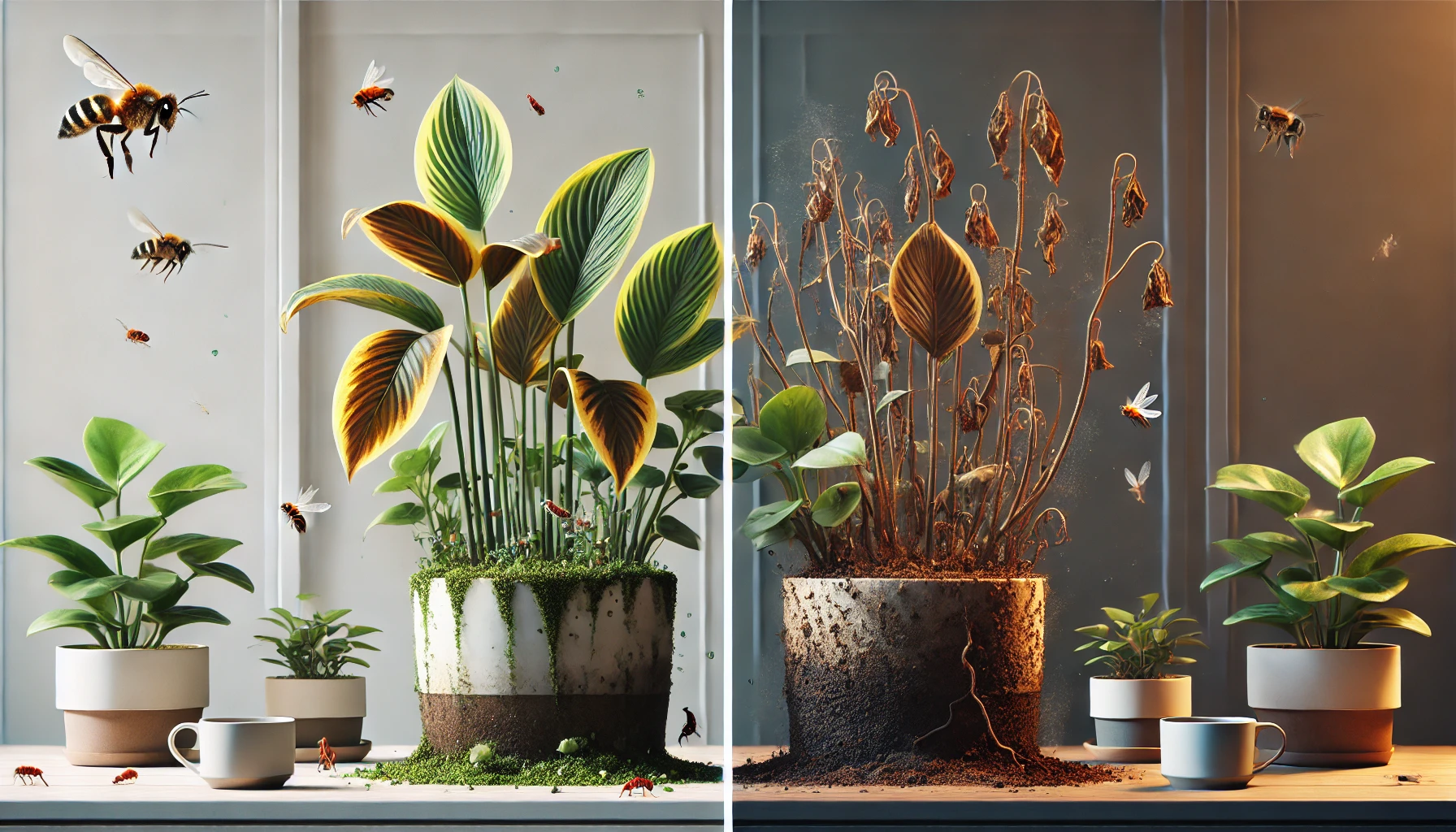
Each plant has its own unique water requirements, and understanding these needs is essential for creating the perfect indoor plant watering schedule. Let’s break it down:
Plant Types and Their Watering Needs 🌱💧
- Succulents & Cacti: These desert dwellers are low-maintenance and thrive on infrequent watering. They prefer dry periods between waterings, so make sure the soil is completely dry before watering again. 🌵
- Tropical Plants (e.g., Monstera, Philodendron, Pothos): These plants love consistently moist soil. Water them once a week or when the top 1-2 inches of soil dry out. 🌿
- Ferns & Calatheas: These humidity-loving plants need more frequent watering and often thrive in slightly damp soil. Keep an eye on the moisture levels to prevent them from drying out. 🍃
- Flowering Plants (e.g., Peace Lily, Anthurium): These beauties need regular watering, especially during blooming. Aim for more frequent watering when they’re flowering, but allow the top of the soil to dry between waterings. 🌸
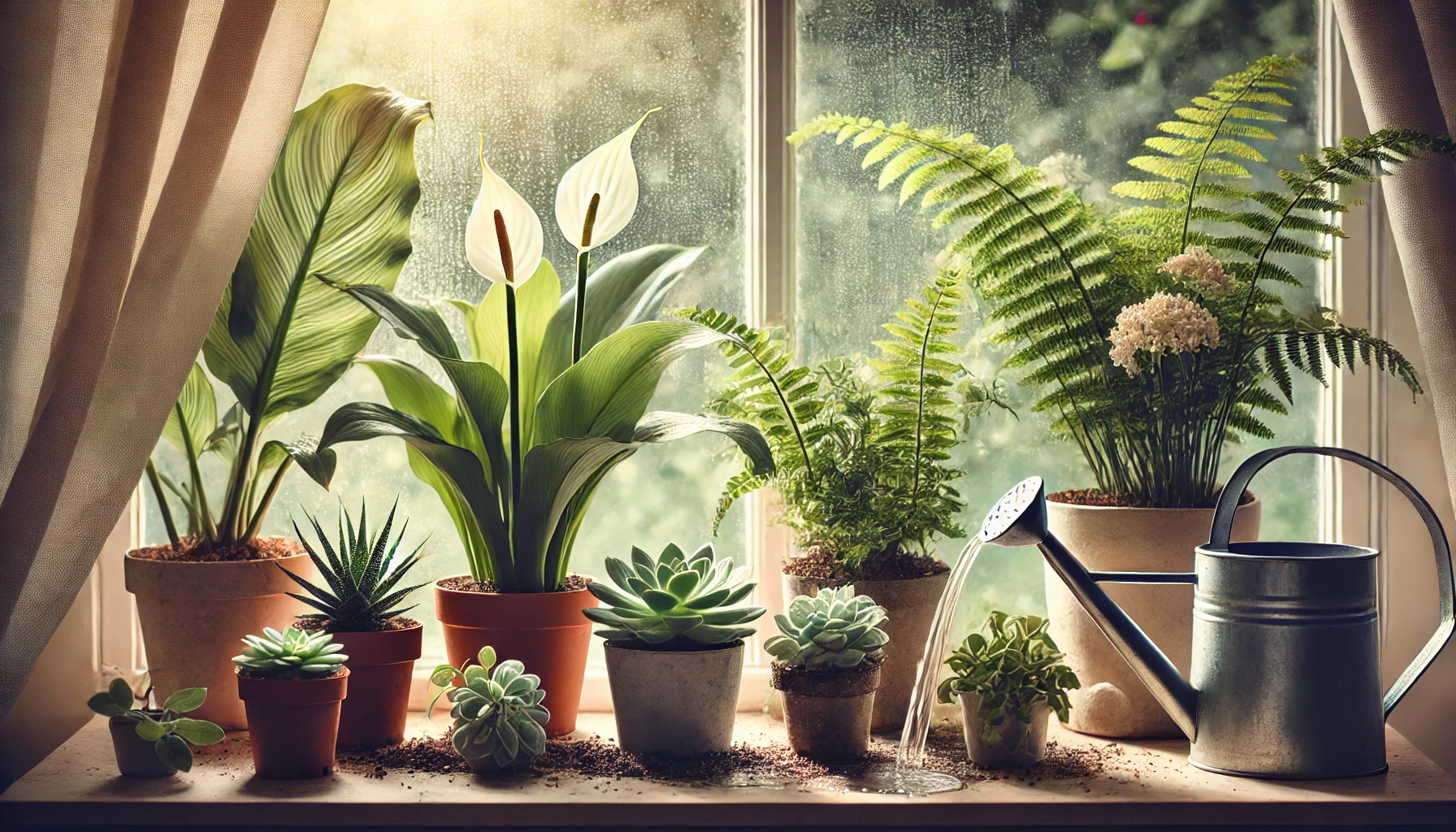
Growth Stage and Water Requirements 🌾🌞
- Seedlings & Young Plants: These tender new growths require more consistent moisture to help them develop strong roots. Make sure their soil stays moist but not soggy. 🌱
- Mature Plants: Established plants generally need less frequent watering since their roots are deeper and more capable of retaining moisture. Still, check the soil regularly to ensure it’s not too dry. 🌿
- Dormant Period (Winter): During winter, most indoor plants slow down and need less water. Reduce watering to avoid root rot, and only water when the soil is completely dry. ❄️
- Active Growing Season (Spring & Summer): Plants are more active and need extra hydration as they grow. Increase watering frequency and make sure the soil doesn’t dry out too quickly. 🌞
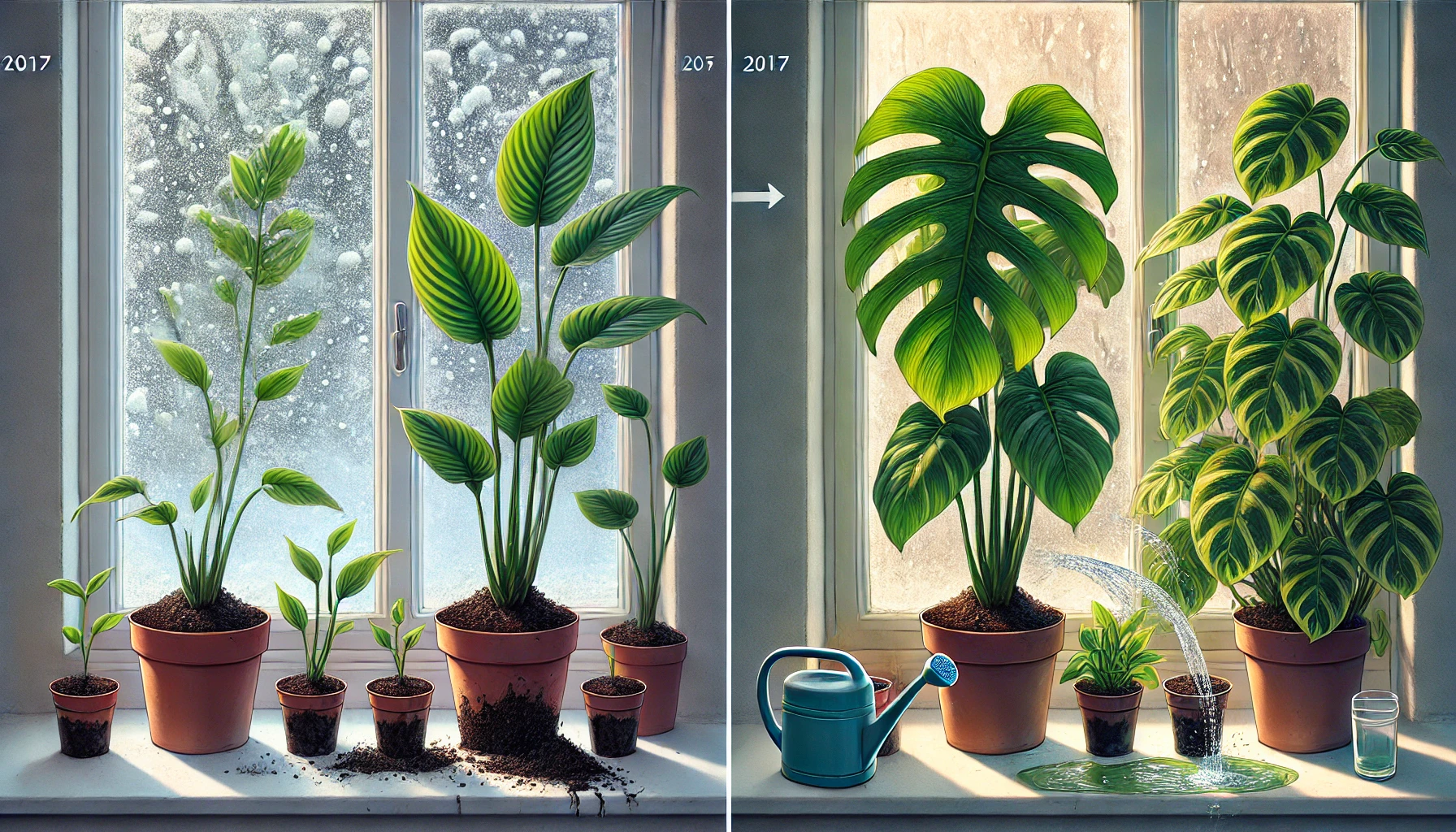
By understanding your plant’s specific needs, you’ll be able to create a tailored indoor plant watering schedule that helps them thrive year-round!
Factors That Influence Indoor Plant Watering 🌱💦
Watering your plants isn’t just about sticking to a schedule—it depends on several factors that affect how quickly soil dries out. Understanding these influences will help you fine-tune your indoor plant watering schedule for healthier plants.
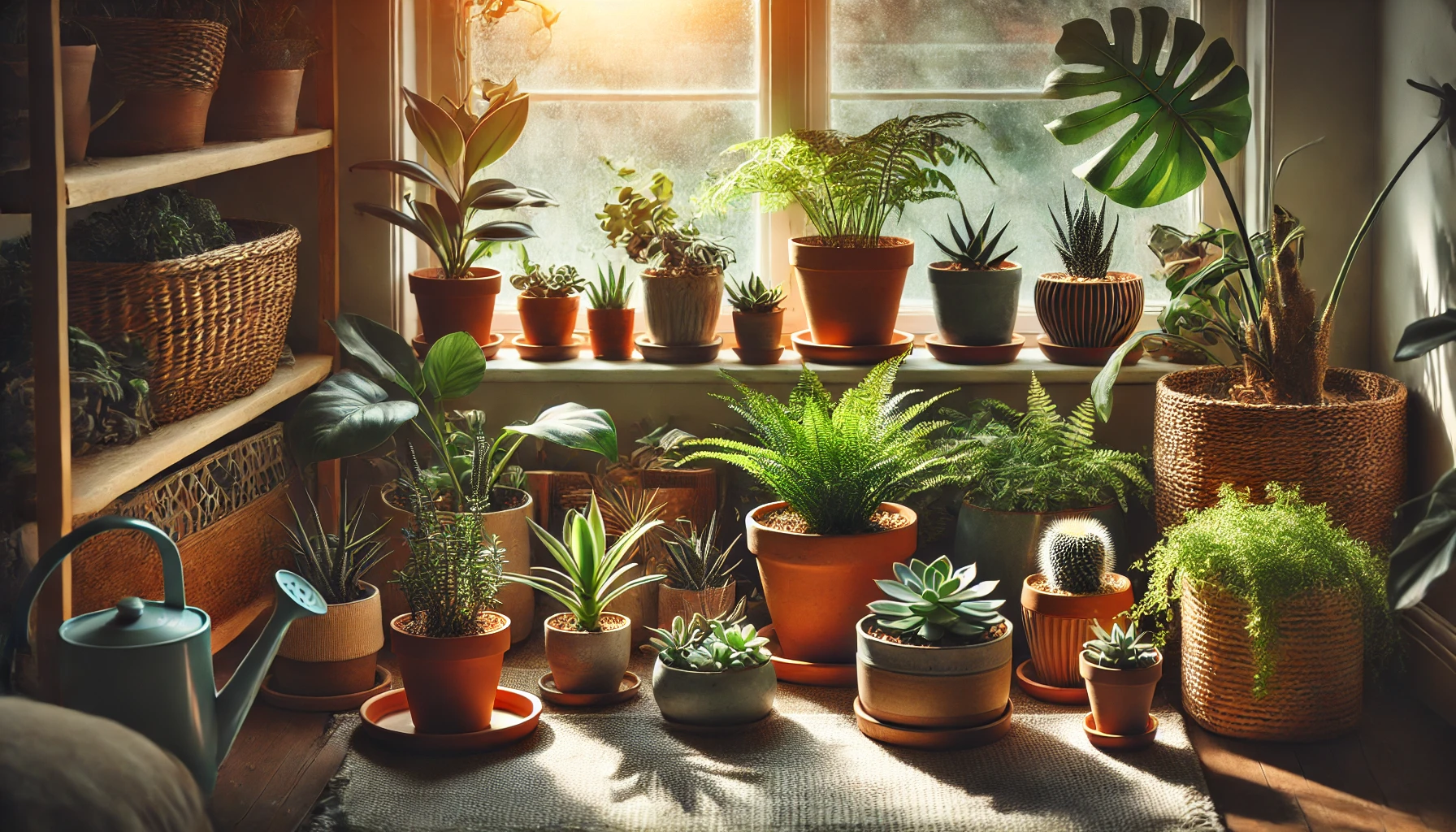
Environmental Factors 🌡️☀️💨
- Temperature & Humidity 🌡️💦
Warm temperatures and low humidity cause soil to dry out faster, while cool, humid conditions help it retain moisture. If you live in a dry climate or use indoor heating, you may need to water more often. - Light Levels ☀️🪴
Plants in bright, direct sunlight lose water faster than those in lower light. A monstera near a sunny window will need more water than one in a dim corner. - Air Circulation 🌬️
Fans, air conditioners, and heaters can speed up soil drying. If your plant is near a vent or draft, check the soil more frequently.
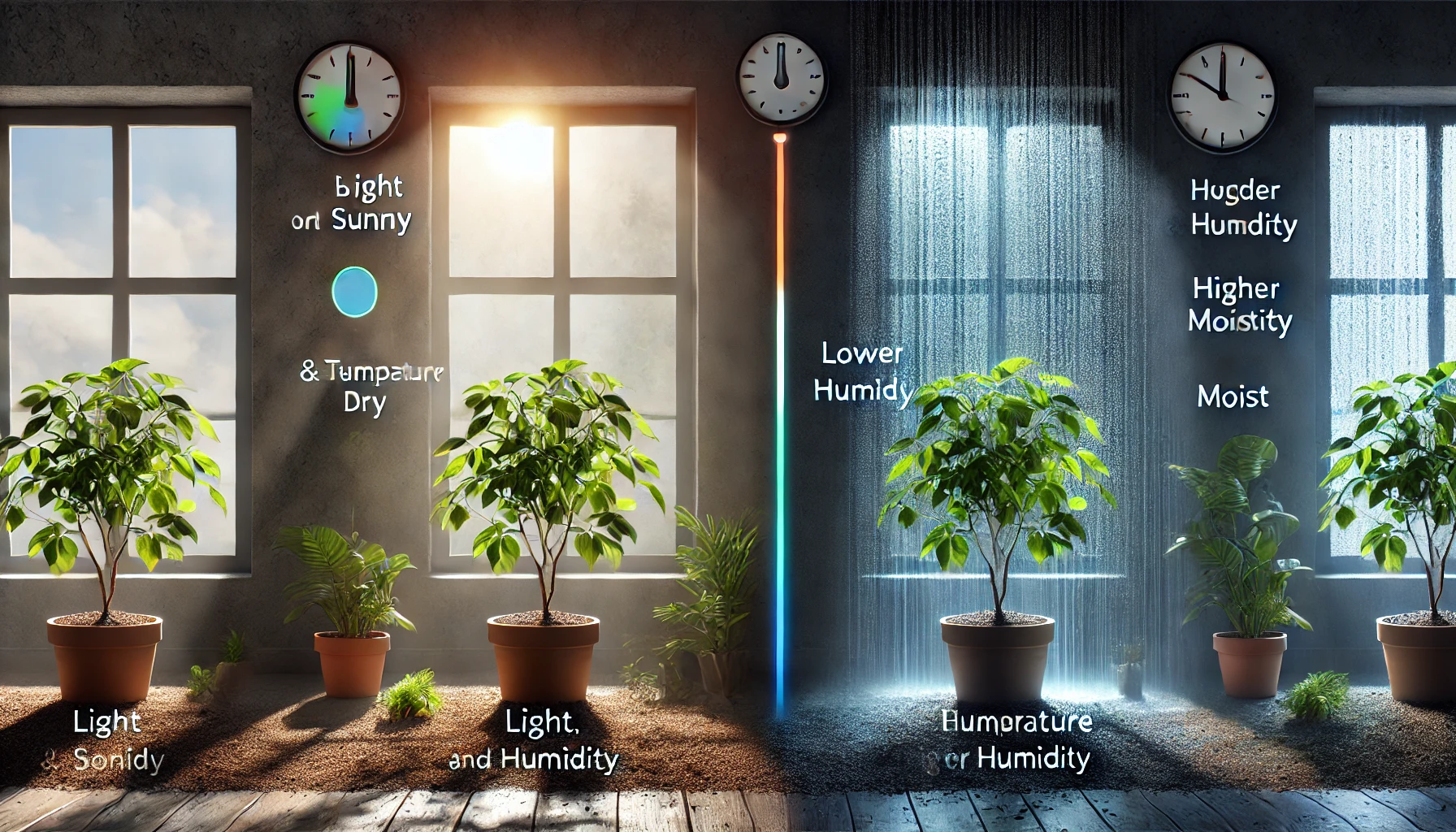
Soil and Pot Considerations 🏺🌱
- Soil Type 🌿
- Well-draining mix (succulents, cacti) → Dries out quickly.
- Moisture-retaining mix (ferns, calatheas) → Holds water longer.
- Heavy soil (clay-based) → Can trap too much moisture and lead to root rot.
- Pot Size 🏺
Large pots hold moisture longer, while small pots dry out faster. Adjust watering based on the size of the container. - Pot Material 🏺 vs. 🪴
- Terracotta → Absorbs moisture, causing soil to dry out faster.
- Plastic/Ceramic → Retains more water, so plants may need less frequent watering.
- Drainage Holes 🚰
Always use pots with drainage holes! They prevent water from pooling at the bottom, reducing the risk of root rot.
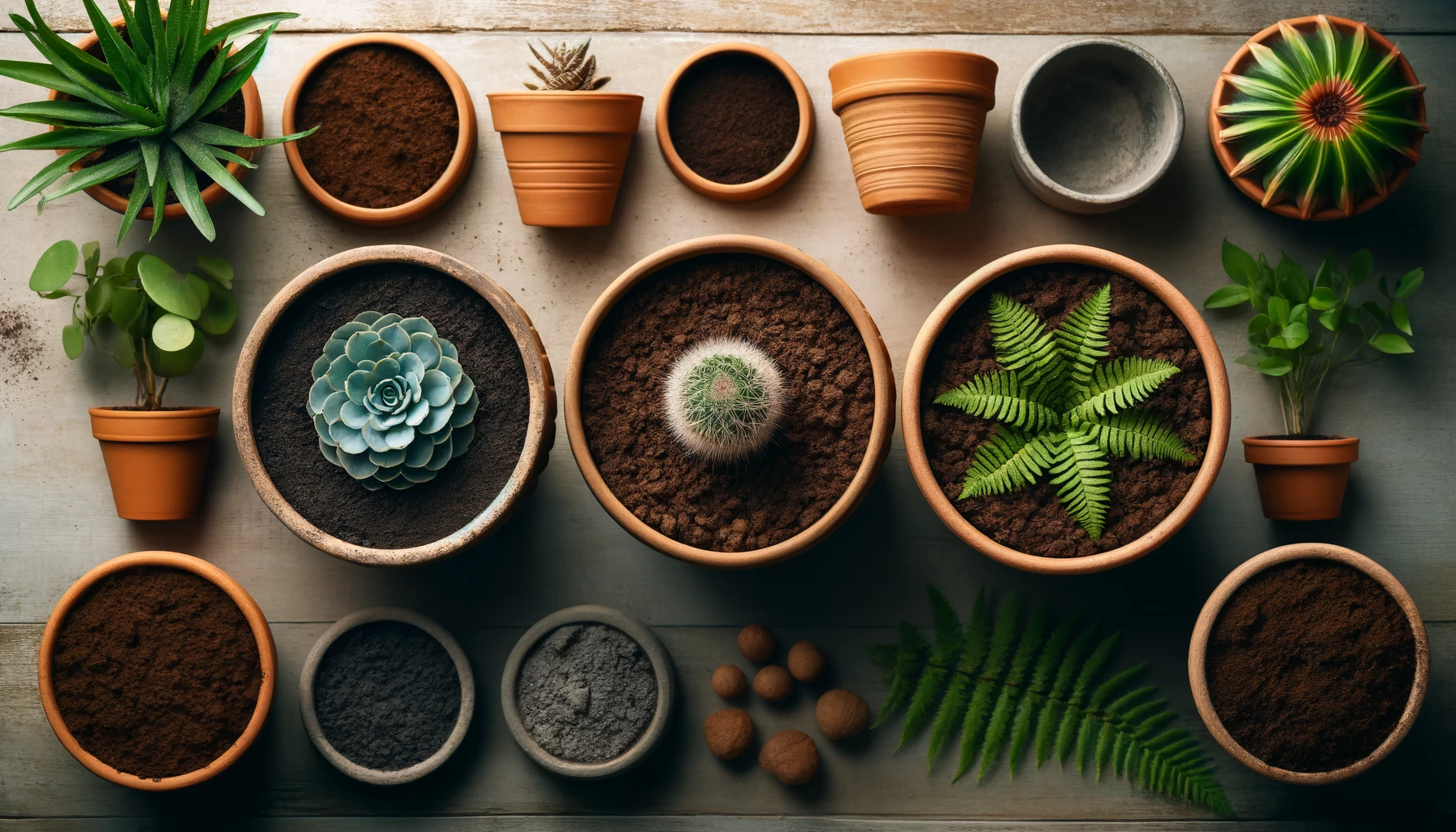
By considering these factors, you can customize your indoor plant watering schedule to match your plant’s environment, keeping it happy and thriving! 🌿💚
How to Create an Effective Indoor Plant Watering Schedule 🗓️💧
A well-planned indoor plant watering schedule keeps your plants hydrated without overdoing it. The key is to water based on plant type, soil moisture, and seasonal changes rather than following a strict routine. Here’s how to create an effective plan!
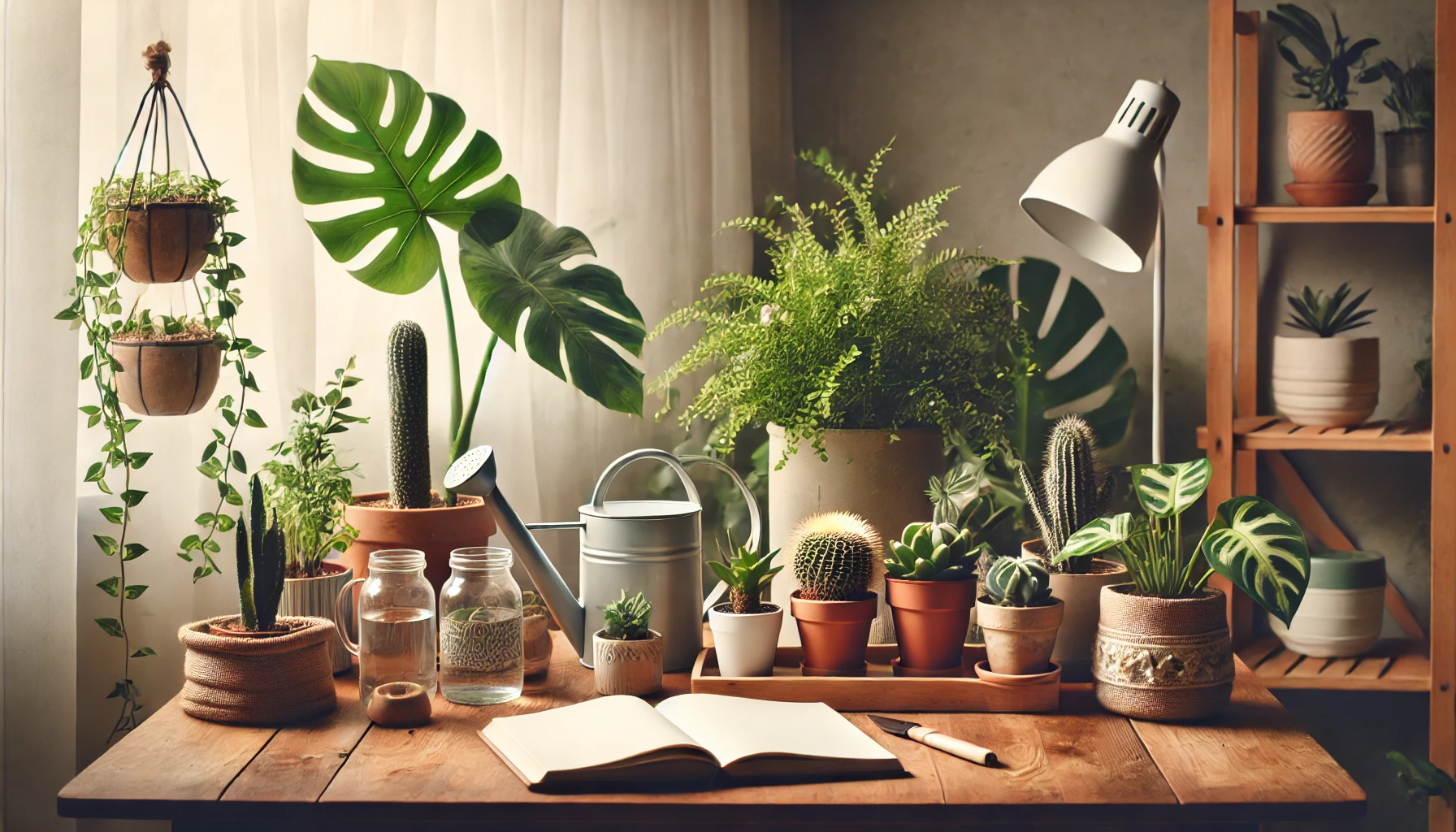
The Best Watering Frequency for Common Houseplants 🌱
- Low-Water Plants (Cacti, Succulents) 🌵 – Water every 2-3 weeks or when the soil is completely dry.
- Medium-Water Plants (Monstera, Pothos, Philodendron) 🌿 – Water weekly or when the top 1-2 inches of soil are dry.
- High-Water Plants (Ferns, Calatheas, Peace Lilies) 🍃 – Water every few days or when the soil feels slightly dry.
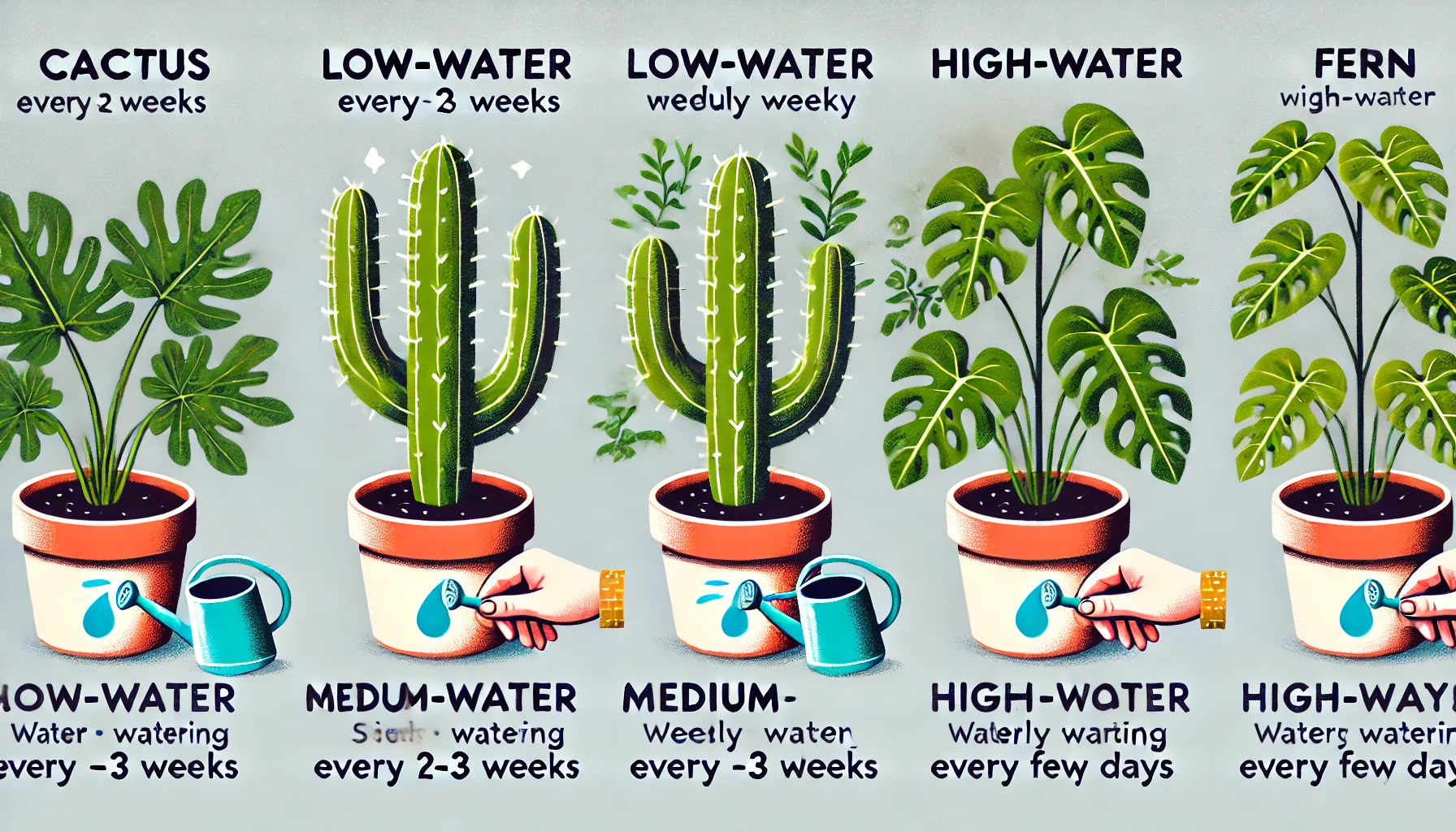
🌟 Tip: Always check soil moisture before watering. Stick your finger in the soil up to an inch—if it’s dry, it’s time to water!
Best Practices for Scheduling Watering ⏳
- Set Reminders 📅 – Use a plant care journal or an app to track watering days.
- Adjust for Seasons ❄️🌞 – Water more in summer when plants grow actively and less in winter when growth slows down.
- Group Plants with Similar Needs 🪴🪴 – Keep humidity-loving plants together to make watering easier.
- Observe Your Plants 👀 – Droopy leaves? Crispy edges? Your plant will tell you when it’s thirsty!
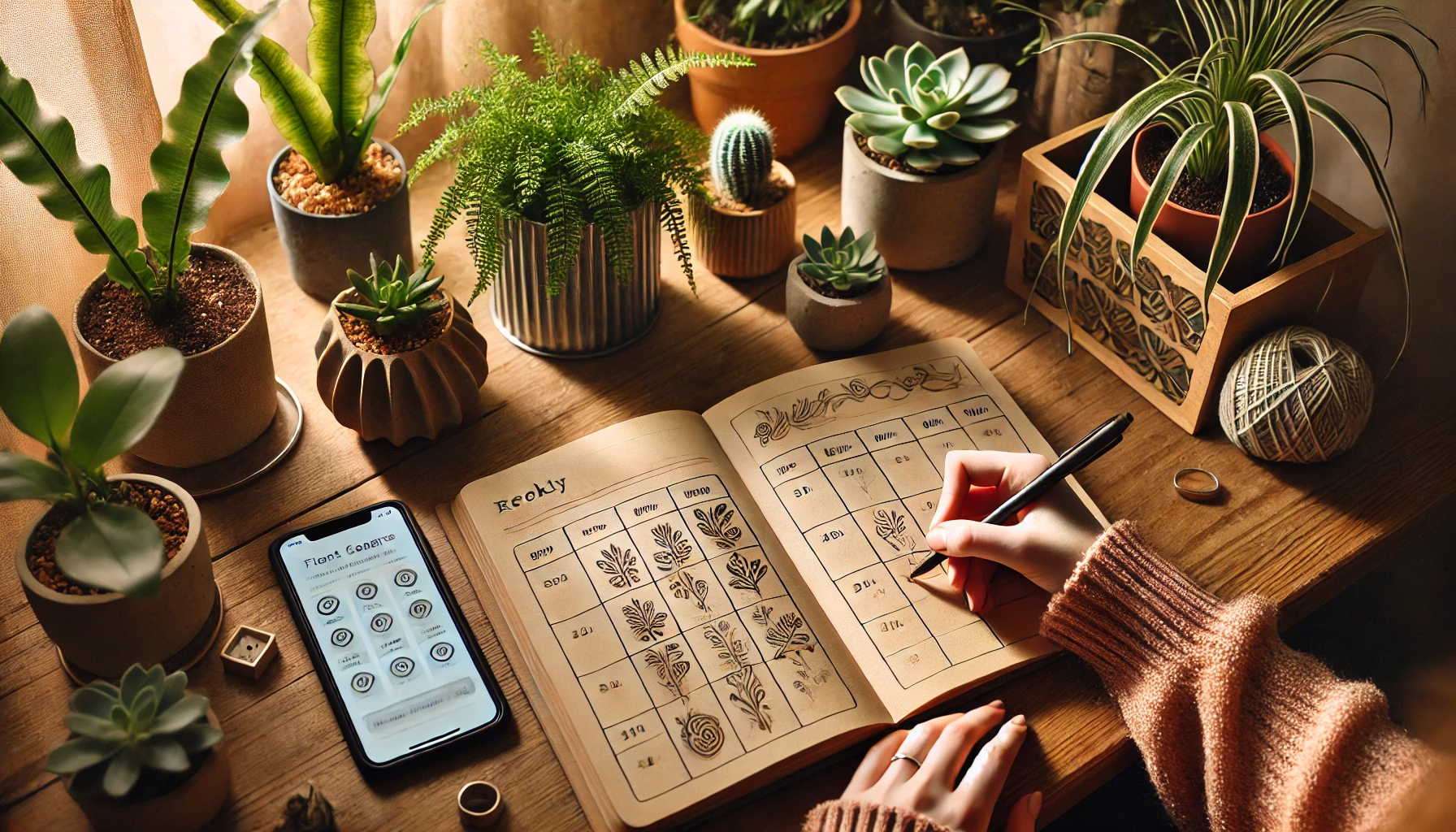
By following these steps, you’ll develop a flexible but reliable indoor plant watering schedule that keeps your plants happy, hydrated, and thriving! 🌿💚
Signs of Overwatering and Underwatering 🚰⚠️
Knowing when to water is just as important as knowing when not to! Overwatering and underwatering are the most common causes of plant stress. Here’s how to spot the signs and fix them.
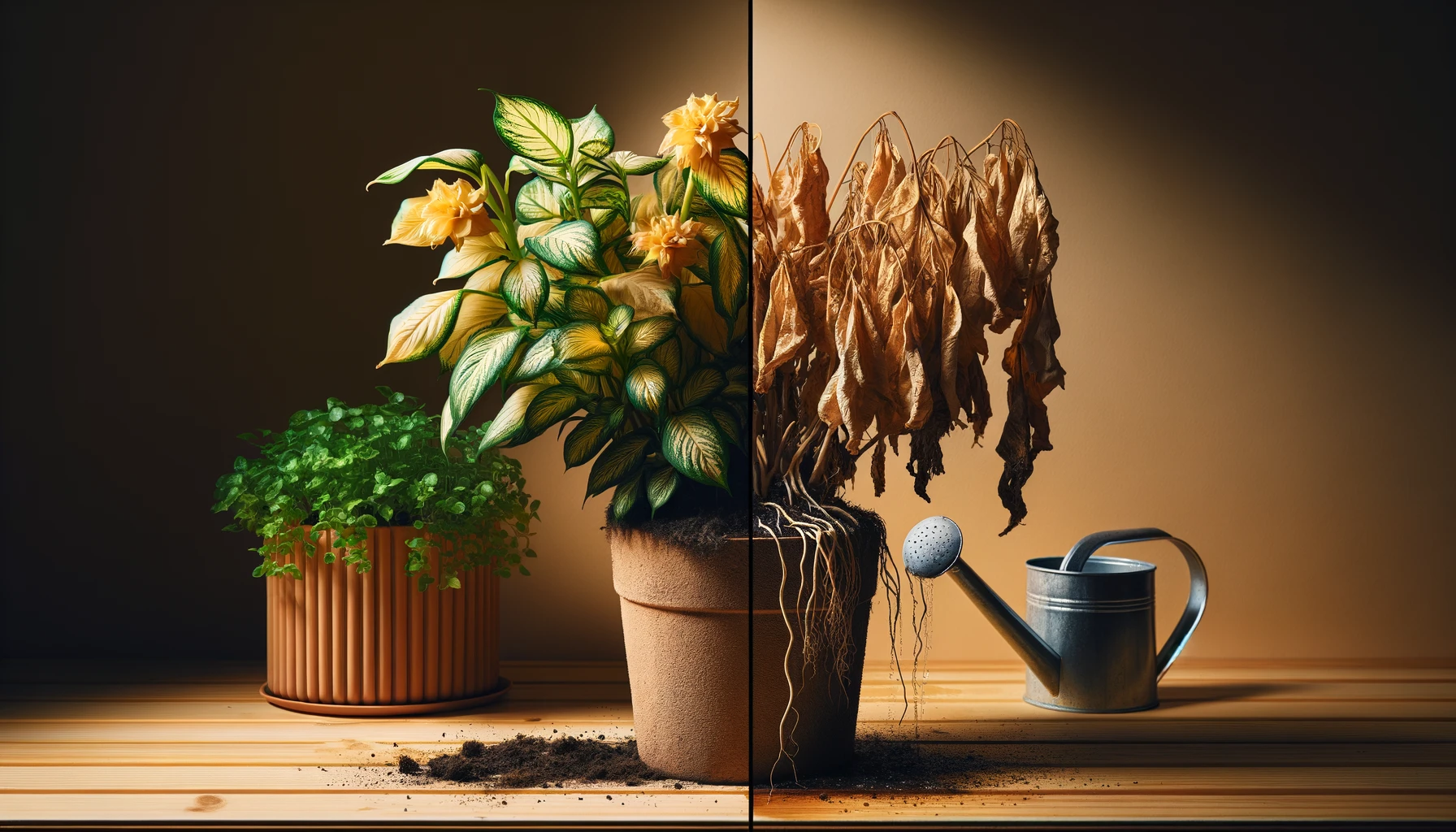
Symptoms of Overwatering 💦🚨
Too much water can drown plant roots, leading to serious problems. Watch for:
- Yellowing Leaves 🍂 – Often the first sign of soggy roots.
- Mushy Stems or Soft Leaves 🥀 – A sign of rot caused by excess moisture.
- Moldy or Musty-Smelling Soil 🦠 – A clear sign of overwatering.
- Fungus Gnats & Algae Growth 🪰 – Constantly wet soil attracts pests and algae.
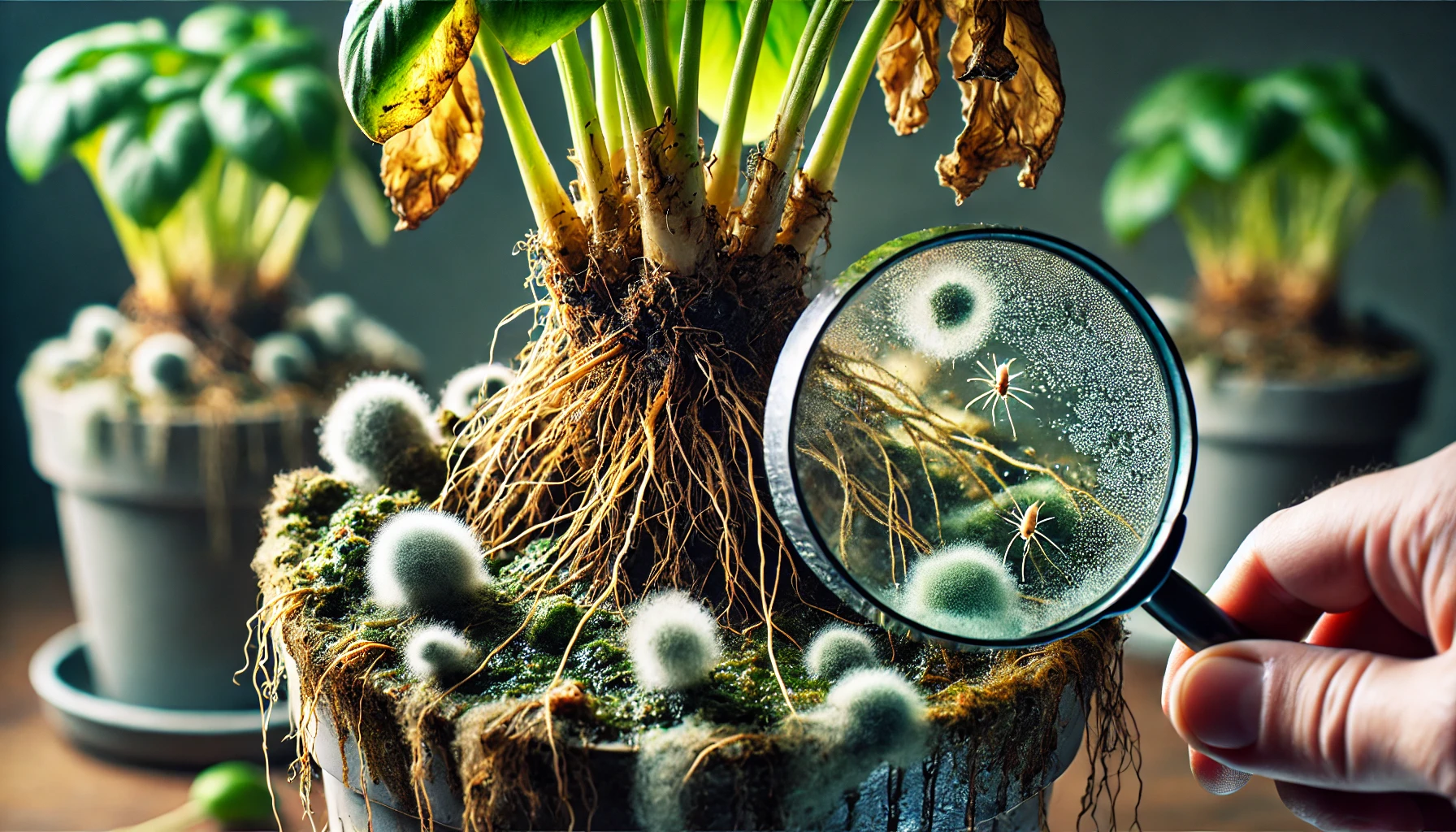
💡 Fix: Let the soil dry out completely before the next watering. If roots are damaged, trim them and repot in fresh, well-draining soil.
Symptoms of Underwatering 🌵🔥
Too little water dehydrates your plant, causing:
- Drooping or Wilting Leaves 🥀 – Leaves lose firmness when lacking water.
- Brown, Crispy Leaf Edges 🍂 – A sign of prolonged dryness.
- Dry, Compacted Soil Pulling Away from the Pot 🏜️ – The soil shrinks when extremely dry, making it harder for roots to absorb water.
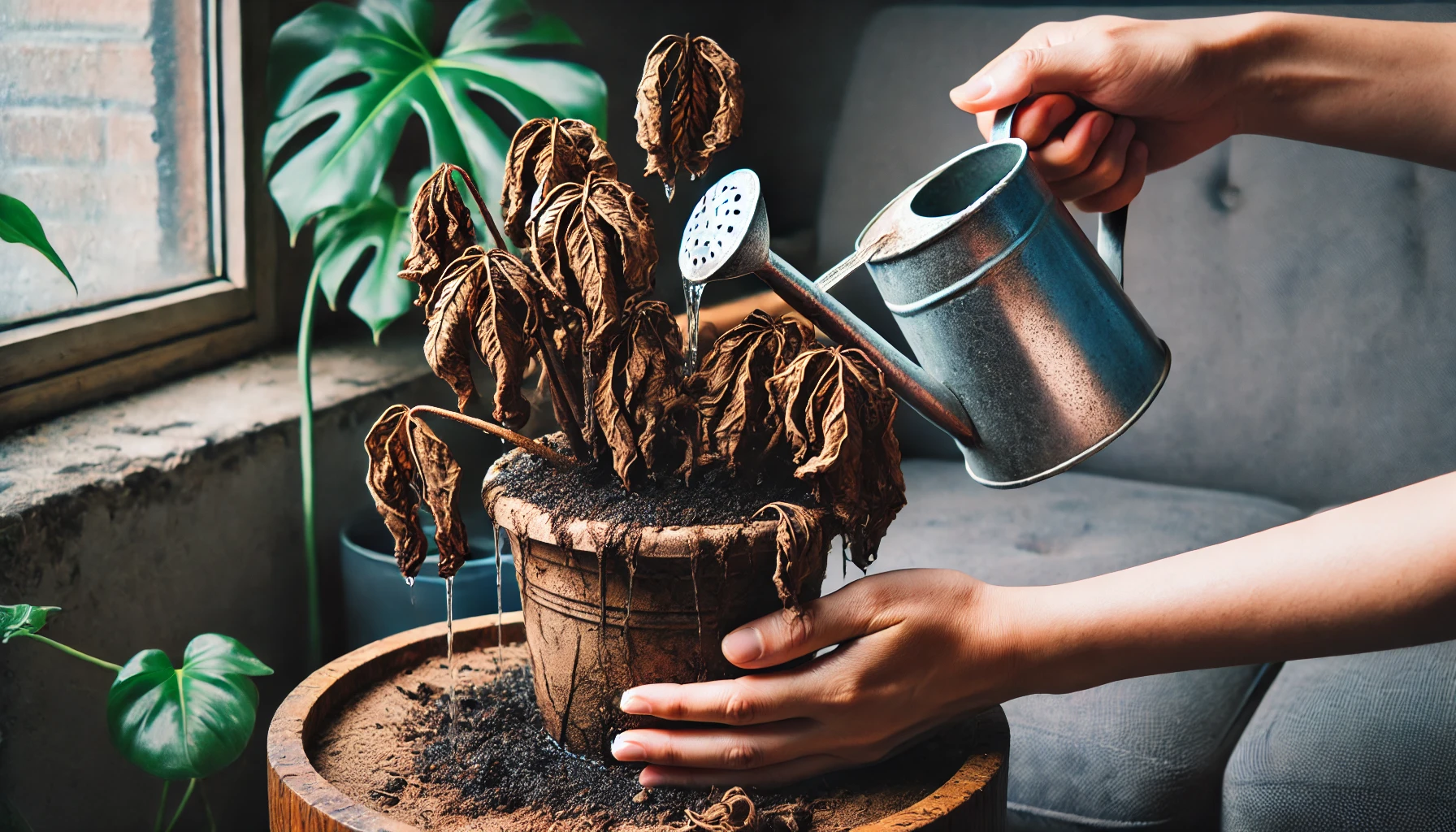
💡 Fix: Gradually rehydrate the plant by watering in small amounts, or use the soaking method for extremely dry soil.
How to Correct Watering Mistakes 🔄
- Overwatered Plant? 🌊 – Improve drainage, repot if necessary, and adjust watering habits.
- Underwatered Plant? 🌵 – Rehydrate slowly to avoid shocking the roots.
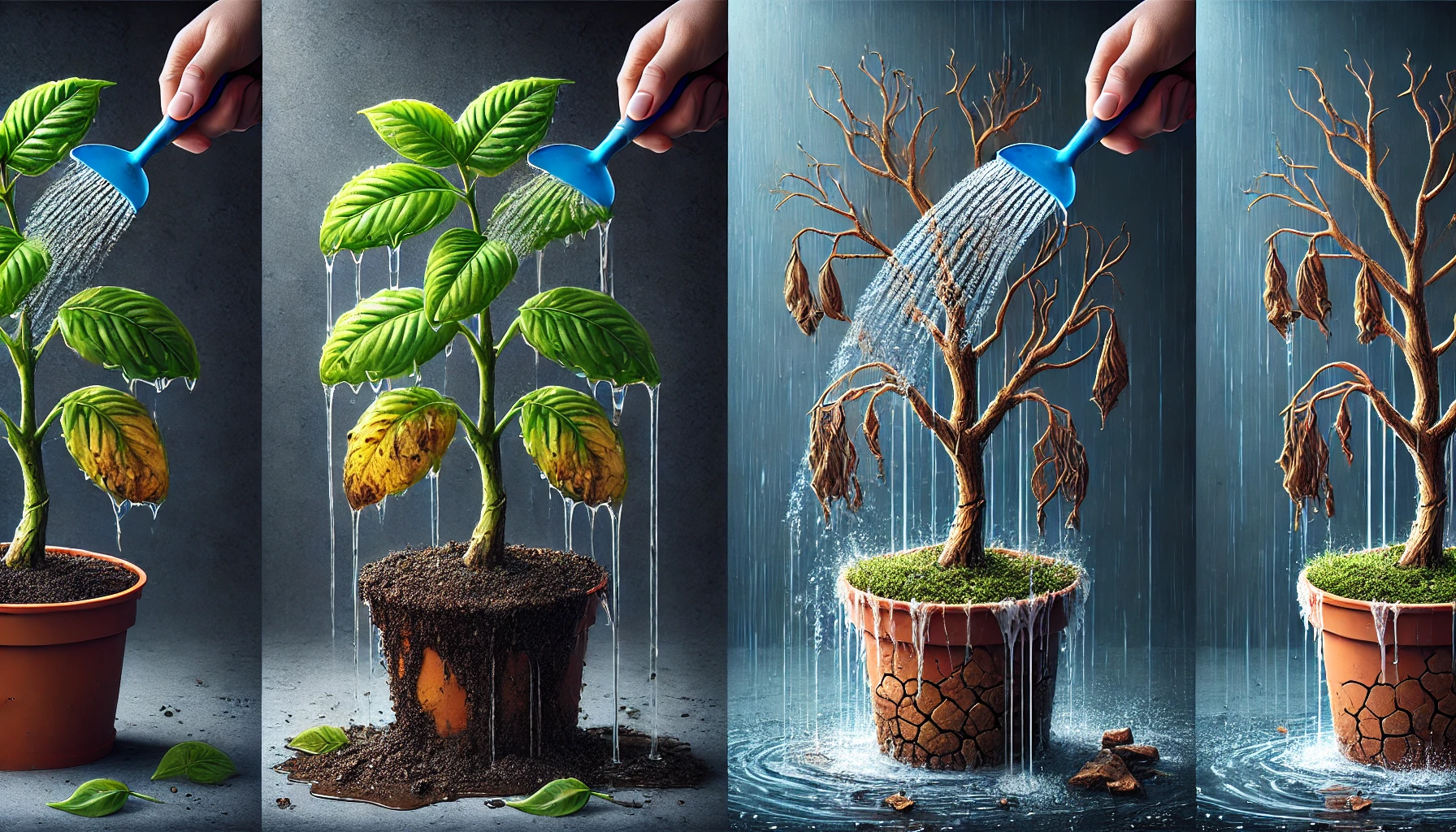
Observing these signs will help you fine-tune your indoor plant watering schedule and keep your plants thriving! 🌿💚
Best Watering Techniques for Indoor Plants 💦🌿
Watering isn’t just about how often you do it—it’s also about how you do it! Using the right technique ensures your plants absorb moisture properly while preventing issues like root rot or dehydration.
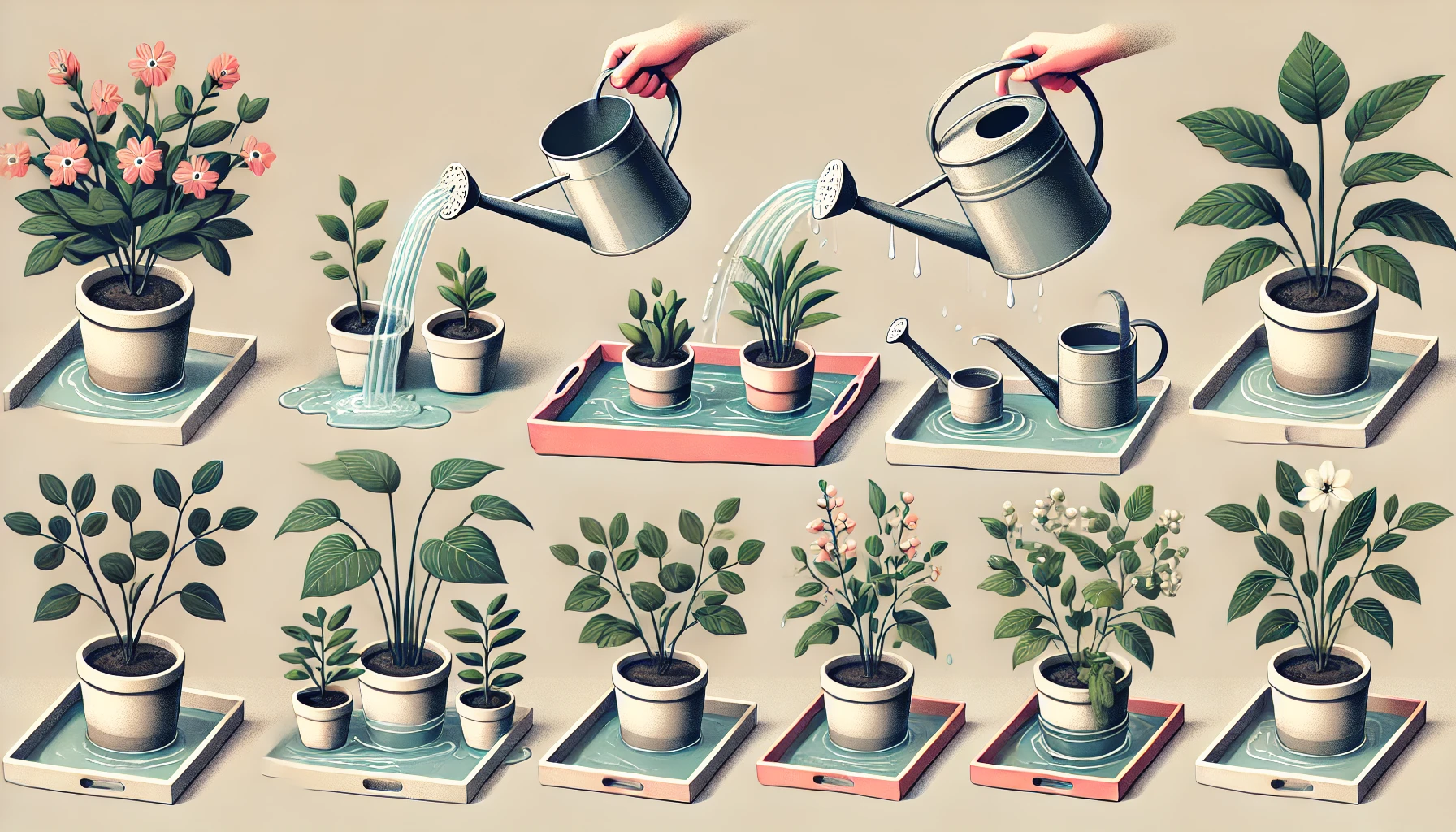
Choosing the Right Watering Method 🚰
- Top Watering ☔ – The most common method! Pour water directly onto the soil until it drains out of the bottom. 🌱
✅ Easy and effective
❌ Can leave dry spots if water doesn’t reach all roots - Bottom Watering 🏺 – Place the pot in a tray of water and let the soil soak up moisture from the bottom. 🌊
✅ Ensures even root hydration
❌ Not ideal for compacted soil that repels water - Soaking Method 💧 – For very dry plants, place the pot in a basin of water for 10-20 minutes until the soil is fully moistened.
✅ Great for reviving underwatered plants
❌ Can overhydrate if done too often - Using Self-Watering Pots 🪴 – These pots have a built-in reservoir to provide consistent moisture.
✅ Reduces watering frequency
❌ Not suitable for plants that prefer drier soil (e.g., succulents)
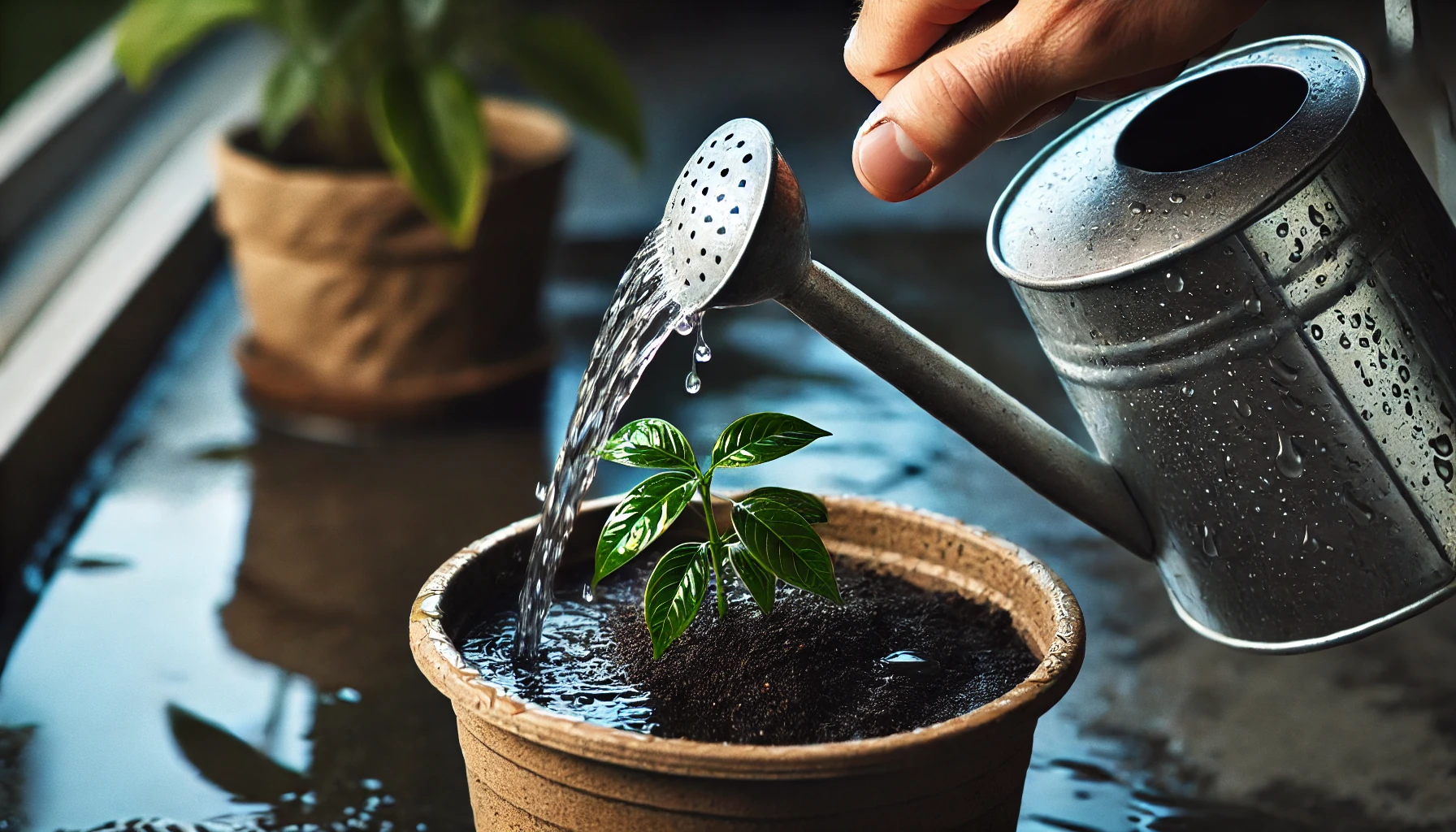
What Type of Water is Best? 🚿
- Tap Water – Works for most plants, but letting it sit overnight helps remove chlorine.
- Filtered or Rainwater 🌧️ – Ideal for sensitive plants like Calatheas that dislike chemicals in tap water.
- Avoid Cold Water ❄️ – Room-temperature water prevents root shock.
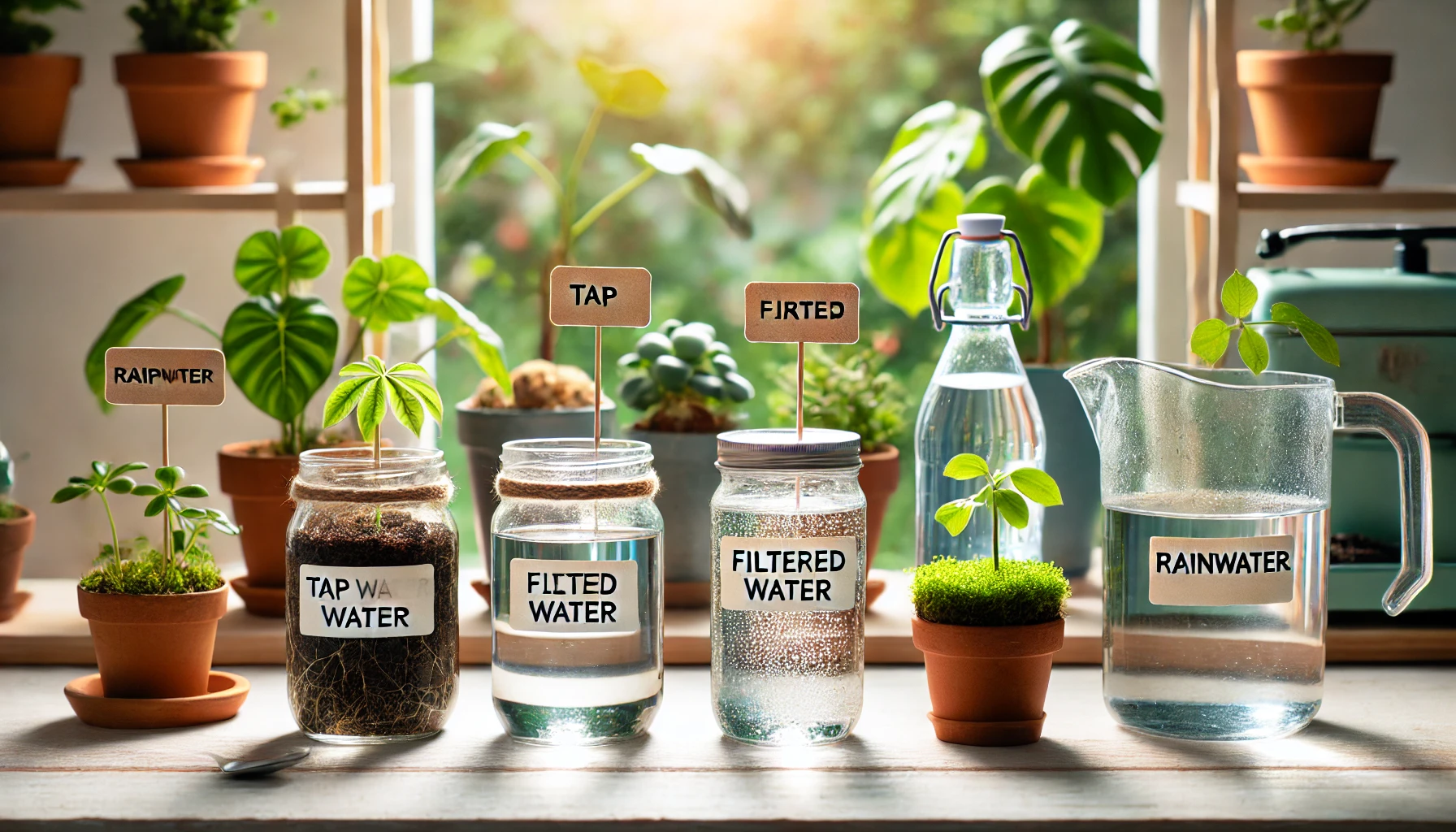
Best Time to Water Plants ⏰
- Morning Watering is Best 🌞 – This allows plants to absorb moisture before temperatures rise.
- Avoid Watering at Night 🌙 – Excess moisture can lead to fungal growth.
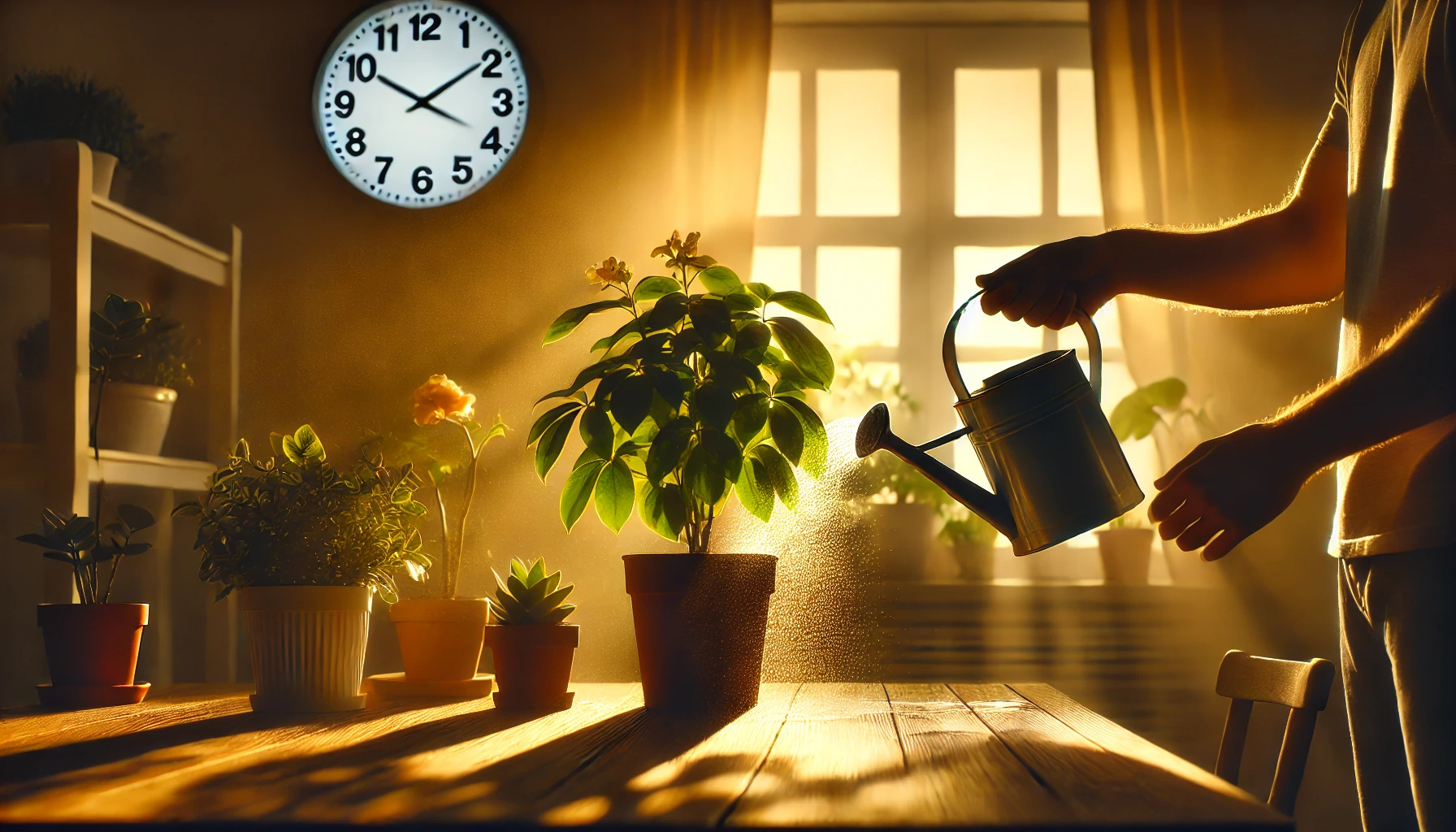
Using these techniques will make your indoor plant watering schedule more effective, keeping your plants healthy and hydrated! 🌿💚
Special Watering Considerations 🌱💦
Sometimes, plants need extra care beyond a basic indoor plant watering schedule. Whether you’re going on vacation, managing humidity, or dealing with tricky plants, here’s how to keep them thriving.
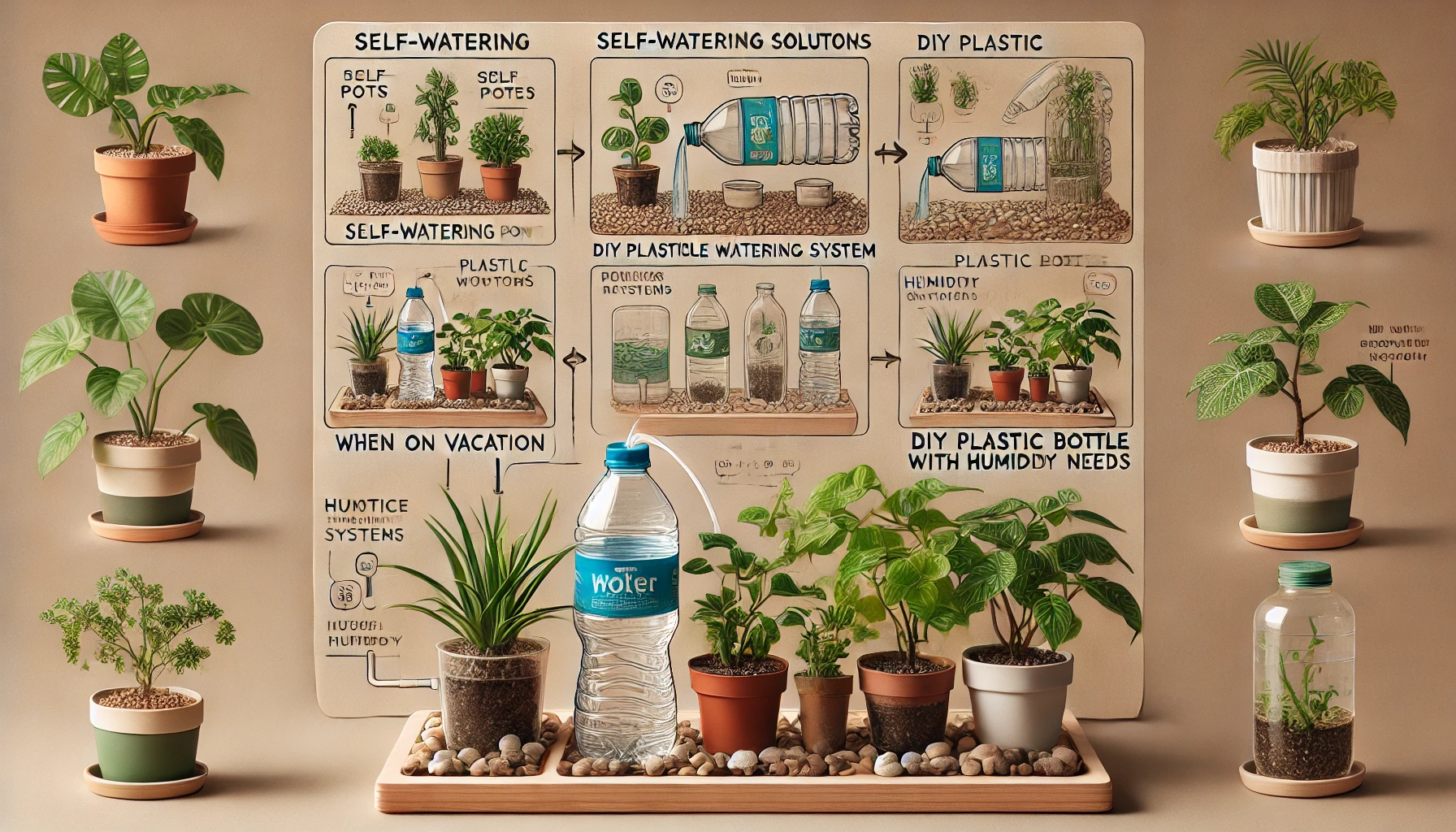
How to Water When You’re on Vacation ✈️🌿
Leaving your plants unattended? Try these easy solutions:
- Self-Watering Systems 🏺 – Use self-watering pots or water reservoirs with wicks to keep soil consistently moist.
- DIY Plastic Bottle Trick 🍼 – Fill a bottle with water, poke a small hole in the cap, and place it upside down in the soil for slow release.
- Capillary Matting Method 🏕️ – Place plants on a damp towel or cloth with one end in a water-filled tray to wick moisture.
- Ask a Friend or Use a Plant-Sitter App 📲 – A quick check-in can prevent watering mishaps.
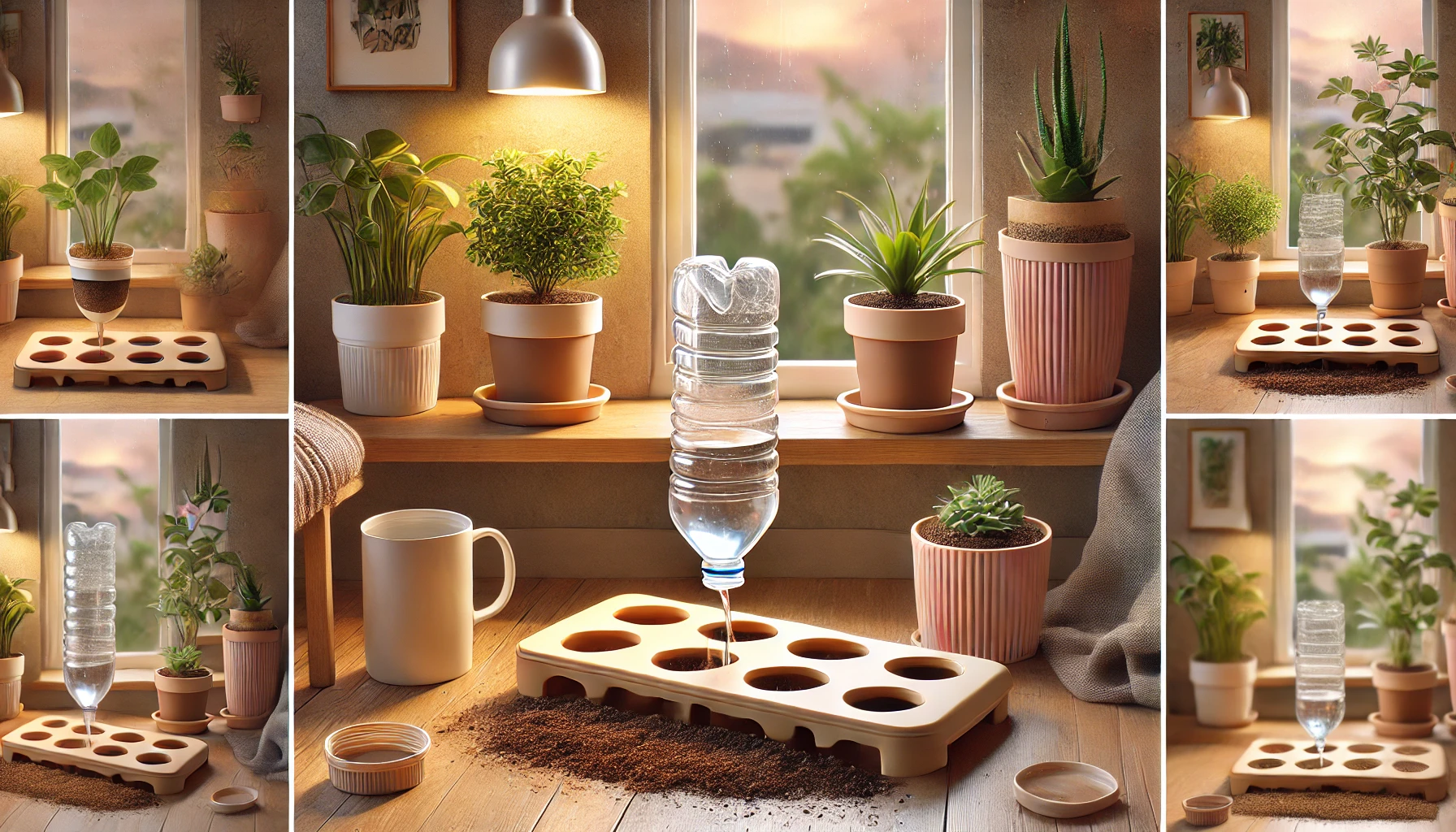
Humidity Considerations for Indoor Plants 💧🌡️
Some plants, like ferns and Calatheas, need more than just soil moisture—they crave humidity!
- Use Pebble Trays 🪴 – Place a shallow tray of water with pebbles under the plant pot.
- Group Plants Together 🌿🌿 – They create a micro-humid environment by releasing moisture.
- Use a Humidifier ☁️ – A great option for tropical plants in dry homes.
- Misting? 🤔 – While misting can temporarily increase humidity, it’s not always effective for long-term moisture needs.

By adjusting your watering methods based on these special conditions, you can maintain a happy, healthy plant collection—even when you’re away! 🌿💚
Seasonal Adjustments to Your Watering Routine 🌞❄️
Your indoor plant watering schedule should change with the seasons! Plants grow actively in warm months and slow down in cooler months, meaning their water needs fluctuate. Here’s how to adjust accordingly.

Summer Watering Tips ☀️💦
- Higher Temperatures = Faster Soil Drying 🔥 – Check soil moisture more often, especially for thirsty plants.
- Increase Watering Frequency 🌿 – Many plants, like Monsteras and Pothos, will need water more frequently in the summer.
- Watch for Signs of Dehydration 🚰 – Drooping leaves, dry soil, and crispy edges signal it’s time to water.
- Use Mulch for Potted Plants 🪵 – A thin layer of moss or coconut coir helps retain moisture.

Winter Watering Tips ❄️🚿
- Plants Grow Slower, So Water Less ⏳ – Overwatering in winter can lead to root rot, as plants use less moisture.
- Prevent Overwatering During Dormancy 💤 – Water only when the soil feels dry to the touch.
- Watch for Dry Indoor Air from Heaters 🔥 – Use a humidifier or pebble trays to prevent leaves from drying out.
- Avoid Cold Water ❄️ – Use room-temperature water to prevent root shock.

By adjusting your watering habits seasonally, you’ll keep your indoor plants hydrated without overdoing it! 🌿💚
Mastering the indoor plant watering schedule is the key to keeping your plants healthy and thriving. By understanding your plant’s needs, adjusting for environmental factors, and using the right watering techniques, you can prevent common issues like overwatering and underwatering.
📌 Key Takeaways
✔️ Check soil moisture before watering—don’t rely on a fixed schedule.
✔️ Adapt your watering routine based on plant type, season, and indoor conditions.
✔️ Use the best watering techniques, like bottom watering or self-watering pots, when needed.
✔️ Watch for signs of stress, such as droopy or yellowing leaves, to adjust your care.
Most importantly, observe your plants! They will tell you when they need water. Keep a journal, experiment with different methods, and find what works best for your plant collection.
Got any plant-watering tips or experiences to share? Drop a comment below! 🌱💬✨
Frequently Asked Questions (FAQ)
How often should I water my indoor plants?
Watering frequency depends on the plant type, pot size, humidity, and season. Most plants need water when the top inch of soil feels dry.
How do I know if my plant needs water?
Check the soil moisture by inserting your finger an inch deep. If it feels dry, water the plant. Drooping leaves or dry edges can also indicate thirst.
What is the best time of day to water indoor plants?
Morning is ideal, as it allows plants to absorb moisture before temperatures rise. This helps prevent water loss due to evaporation.
Should I water plants on a fixed schedule?
Instead of a rigid schedule, base watering on the plant’s needs. Regularly check soil moisture and adjust according to environmental conditions.
Can I use tap water for my plants?
Most plants tolerate tap water, but let it sit overnight to allow chlorine to dissipate. Sensitive plants may prefer filtered or rainwater.
How do I prevent overwatering?
Use well-draining soil, pots with drainage holes, and avoid watering if the soil is still moist. Yellowing leaves and mushy stems indicate overwatering.
What are signs of underwatering?
Dry, crispy leaves, drooping, and slow growth suggest underwatering. If the soil pulls away from the pot’s edges, it may need a deep soak.
How does humidity affect watering needs?
Higher humidity slows water loss, reducing the need for frequent watering. In dry environments, plants may need more water and occasional misting.
A well-balanced watering schedule keeps plants thriving. Observe your plants and adjust based on their specific needs for healthy growth.
